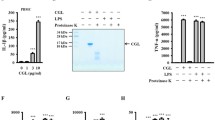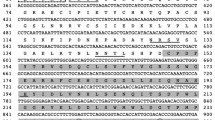Abstract
Studies on inducible ascidian lectins may shed light on the evolutionary emergence of cytokine functions. Here, we show that the levels of opsonins, with IL1α-epitopes, increase in Ciona intestinalis hemolymph as a response to an inflammatory stimulus and, in particular, to intratunic injection of lipopolysaccharide (LPS). The inflammatory agent promptly (within 4 h) enhances Ca2+-independent serum hemagglutinating and opsonizing activities, which are both inhibited by D-galactose and D-galactosides (α-lactose, N-acetyl-D-lactosamine, thio-digalactoside), suggesting that anti-rabbit erythrocyte lectins with galectin properties are involved as opsonins. Inducible galectin molecules contain interleukin-1α (IL1α) epitopes, and their activities are specifically inhibited by anti-human recombinant IL1α antibody. Analysis by SDS-polyacrylamide gel electrophoresis has revealed that the density of the bands of several serum proteins increases within 4 h after LPS injection, correlated with the enhanced serum activity. Moreover, Western blot patterns demonstrate that several serum proteins (59, 37, 30, 23, 15 kDa) cross-react with the antibody as early as 4 h post-injection. Although we have not been able to establish whether, in adition to galectins, various types of D-galactose-specific lectins are contained in the serum, we show, for the first time in invertebrates, that galectin molecules with opsonic properties can be enhanced in response to a non-specific inflammatory stimulus, and that their release can be further stimulated by LPS. Finally, we reveal that multiple galectins share human IL1α epitopes, probably because of steric configuration and the oligomerization process.





Similar content being viewed by others
References
Abe Y, Tokuda M, Ishimoto R, Azumi K, Yokosawa H (1999) A unique primary structure, cDNA cloning and function of a galactose-binding lectin from ascidian plasma. Eur J Biochem 261:33–39
Azumi K, De Santis R, De Tomaso A, Rigoutsos I, Yoshizaki F, Pinto MR, Marino R, Shida K, Ikeda M, Ikeda M, Arai M, Inoue Y, Shimizu T, Satoh N, Rokhsar DS, Du Pasquier L, Kasahara M, Satake M, Nonaka M (2003) Genomic analysis of immunity in a urochordate and the emergence of the vertebrate immune system: “waiting for Godot”. Immunogenetics 55:570–81
Ballarin L, Cima F, Sabbadin A (1994) Phagocytosis in the colonial ascidian, Botryllus schlosseri. Dev Comp Immunol 18:467–481
Ballarin L, Tonello C, Guidolin L, Sabbadin A (1999) Purification and characterization of a humoral opsonin, with specificity for D-galactose, in the colonial ascidian Botryllus schlosseri. Comp Biochem Physiol [B] 123:115–123
Ballarin L, Tonello C, Sabbadin A (2000) Humoral opsonin from the colonial ascidian Botryllus schlosseri as a member of the galectin familiy. Marine Biol 136:823–827
Beck G, Habicht G (1996) Cytokines in invertebrates. In: Söderhäll K, Iwanaga S, Vasta GR (eds) New directions in invertebrate immunology. SOS publications, Fair Haven, N.J., pp 131–154
Beck G, Vasta G, Marchalonis J, Habicht G (1989) Characterization of an interleukin 1 activity in tunicates. Comp Biochem Physiol 92B:93–98
Beck G, O’Brein RF, Habicht GS, Stillman DL, Cooper EL, Raftos DA (1993) Invertebrate cytokines. III. Interleukin-1-like molecules stimulate phagocytosis by tunicate and echinoderm cells. Cell Immunol 146:284–299
Beschin A, Bilej M, Magez S, Lucas R, De Baetselier P (2004) Functional convergence of invertebrate and vertebrate cytokine-like molecules based on a similar lectin-like activity. Prog Mol Subcell Biol 34:145–163
Bradford MM (1976) A rapid and sensitive method for the quantitation of microgram quantities of proteins utilizing the principles of protein-dye binding. Anal Biochem 72:248–254
Brody DT, Durum SK (1989) Membrane IL-1: IL-1 alpha precursor binds to the plasma membrane via a lectin-like interaction. J Immunol 143:1183–1187
Cammarata M, Arizza V (1994) Method for phagocytosis fluorescence quencing in vitro assay for hemocytes in tunicates. Anim Biol 3:173–174
Cammarata M, Vazzana M, Chinnici C, Parrinello NA (2001) Serum fucolectin isolated and characterized from sea bass Dicentrarchus labrax. Biochim Biophys Acta 1528:196–202
Cebo C, Dambrouck T, Maes E, Laden C, Strecker G, Michalski JC, Zanetta JP (2001a) Recombinant human interleukins IL-1alpha, IL-1beta, IL-4, IL-6, and IL-7 show different and specific calcium-indipendent carbohydrate-binding properties. J Biol Chem 276:5685–5691
Cebo C, Dambrouck T, Maes E, Laden C, Strecker G, Michalski J-C, Zanetta J-P (2001b) Recombinant interleukins IL-1 , IL-1 , IL-4, IL-6, and IL-7 show different and specific calcium-independent carbohydrate-binding properties. J Biol Chem 276:5685–5691
Cebo C, Vergoten G, Zanetta JP (2002) Review. Lectin activities of cytokines: functions and putative carbohydrate-recognition domains. Bioch Biophys Acta 1572:422–434
Cooper DNW, Barondes SH (1999) God must love galectins; He made so many of them. Glycobiology 9:979–984
Dehal P, Satou Y, Campbell RK, Chapman J, Degnan B, De Tommaso A, Davidson B, Di Gregorio A, Gelpke M, Goodstein DM et al (2002) The draft genome of Ciona intestinalis: insights into chordate and vertebrate origins. Science 298:2157–2167
Delsuc F, Baurain D, Philippe H (2006) Origines des vertébrés: la tunique fait-elle le moine? Med Sci 22:688–690
Dodd RB, Drickamer K (2001) Lectin-like proteins in model organisms: implications for evolution of carbohydrate binding activity. Glycobiology 11:71–79
Drickamer K, Taylor JL (1993) Biology of animal lectins. Annu Rev Cell Biol 9: 237–264
Field KG, Olsen GJ, Giovannoni SJ, Ghiselin MT, Raff EC, Pace NR, Raff RA (1988) Molecular phylogeny of the animal kingdom. Science 239:748–753
George AJ (1994) Surface-bound cytokines—a possible effector-mecchanism in bacterial immunity. Immunol Today 15:88–89
Green PL, Nair SV, Raftos DA (2003) Secretion of a collectin-like protein in tunicates is enhanced during inflammatory responses. Dev Comp Immunol 27:3–9
Hori H, Osawa S (1987) Origin and evolution of organisms as deduced from 5S ribosomal RNA sequences. Mol Biol Evol 5:445–72
Kelly K, Cooper EL, Raftos DA (1992) Purification and characterization of a humoral opsonin from the solitary urochordate, Styela clava. Comp Biochem Physiol 103B:749–753
Kelly K, Cooper EL, Raftos DA (1993) A humoral opsonin from the solitary urochordate, Styela clava. Dev Comp Immunol 17:29–39
Laemmli UK (1970) Cleavage of structural protein during the assembly of the head of bacteriophage T4. Nature 227:680–685
Lucas R, Magez S, Leys R de, De Baetselier P (1994) Cytokines: multifunctional pathogen-specific mammalian lectins? In: Van Driessche E, Fisher J, Beeckmans S, Bog-Hansen TC (eds) Lectins: biology, biochemistry, clinical biochemistry, vol 10. Textop, Hellerup, Denmark pp 244–249
Luo G, Nielsen DW, Shaban RA, Grimm EA, Klimpel GR (1993) Tumor necrosis factor alpha binding to bacteria: evidence for a high-affinity receptor and alteration of bacterial virulence properties. Infect Immun 61:830–835
Magez S, Radwanska M, Stijlemans B, Xong HV, Pays E, De Baetselier P (2001) A conserved flagellar pocket exposed high mannose moiety is used by African trypanosomes as a host cytokine binding molecule. J Biol Chem 276:33458–33464
Nair S, Burandt M, Hutchinson A, Raison R, Raftos D (2001) A C-type lectin from the tunicate, Styela plicata, that modulates cellular activity. Comp Biochem Physiol 129:11–24
Parrinello N (1981) The reaction of Ciona intestinalis L. to subcuticular erythrocyte and protein injection. Dev Comp Immunol 5:105–110
Parrinello N, Canicatti C (1982) Carbohydrate binding specificity and purification by biospecific affinity chromatography of Ascidia malaca Traust. hemagglutinins. Dev Comp Immunol 6:53–64
Parrinello N, Patricolo E (1975) Erythrocyte agglutinins in the blood of certain ascidians. Experientia 31:1092–1093
Parrinello N, Patricolo E, Canicattì C (1984a) Inflammatory-like reaction in the tunic of Ciona intestinalis (Tunicata). Encapsulation and tissue injury II. Biol Bull 167:238–250
Parrinello N, Patricolo E, Canicattì C (1984b) Inflammatory-like reaction in the tunic of Ciona intestinalis (Tunicata). Encapsulation and tissue injury I. Biol Bull 167:229–237
Parrinello N, De Leo G, Di Bella MA (1990) Fine structural observations of the granulocytes involved in the tunic inflammatory-like reaction of Ciona intestinalis (Tunicata). J Inv Pathol 56:181–189
Pearce S, Newton RA, Nair SV, Raftos DA (2001) Humoral opsonins of the tunicate, Pyura stolonifera. Dev Comp Immunol 25:377–385
Pinto MR, Chinnici CM, Kimura Y, Melillo D, Marino R, Spruce LA, De Santis R, Parrinello N, Lambris JD (2003) CiC3-1a-mediated chemotaxis in the deuterostome invertebrate Ciona intestinalis (Urochordata). J Immunol 171:5521–5528
Quesenberry MH, Ahmed H, Elola MT, O’Leary N, Vasta GR (2003) Diverse lectin repertoires in tunicates mediate broad recognition and effector innate immune responses. Integr Comp Biol 43:323–330
Raftos D (1996) Interactions of tunicate immunomodulatory proteins with mammalians cells. Immunol Cell Biol 74:26–31
Raftos DA, Cooper EL (1991) Proliferation of lymphocyte-like cells from the solitary tunicate, Styela clava, in response to allogeneic stimuli. J Exp Zool 260:391–400
Raftos D, Nair S (2004) Tunicate cytokine-like molecules and their involvement in host defense responses. Prog Mol Subcell Biol 34:165–182
Raftos DA, Green PL, Mahajan D, Newton RA, Pearce S, Peters R, Robbins J, Nair SV (2001) Collagenous lectins in tunicates and the proteolytic activation of complement. Adv Exp Med Biol 484:229–236
Rice P, Longden I, Bleasby A (2000) EMBOSS: the European molecular biology open software suite. Trends Genet 16:276–277
Sharon N, Lis H (2003) Lectins, 2nd edn. Kluwer Academic, London
Shida K, Terajima D, Uchino R, Ikawa S, Ikeda M, Asano K, Watanabe T, Azumi K, Nonaka M, Satou Y, Satoh N, Satake M, Kawazoe Y, Kasuya A (2003) Hemocytes of Ciona intestinalis express multiple genes involved in innate immune host defense. Biochem Biophys Res Commun 302:207–218
Söderhall K, Smith VJ (1986) The prophenoloxidase activating system. The biochemistry of its activation and role in arthropod cellular immunity with reference to crustaceans. In: Brehelim M (ed) Immunity in invertebrates. Springer, Berlin Heidelberg New York, pp 208–223
Stratton L, Wu S, Richards RC, Ewart KV (2004) Oligomerisation and carbohydrate binding in Atlantic salmon serum C-type lectin consistent with non-self recognition. Fish Shellfish Immunol 17:315–323
Swaminathan GJ, Leonidas DD, Savage MP, Ackerman SJ, Achayra KR (1999) Selective recognition of mannose by the human eosinophil Charcot-Leydon crystal protein (galectin 10): a crystallographic study at 1.8 Å resolution. Biochemistry 38:13837–13843
Terajima D, Yamada S, Uchino R, Ikawa S, Ikeda M, Shida K, Arai Y, Wang HG, Satoh N, Satake M (2003) Identification and sequence of seventy-nine new transcripts expressed in hemocytes of Ciona intestinalis, three of which may be involved in characteristic cell-cell communication. DNA Res 10:203–212
Vasta GR, Ahmed H, Odom EW (2004) Structural and functional diversity of lectin repertoires in invertebrates, protochordates and ectothermic vertebrates. Curr Opin Struct Biol 14:617–630
Vasta GR, Hunt JC, Marchalonis JJ, Fish WW (1986) Galactosyl-binding lectins from the tunicate Didemnum candidum. Purification and physicochemical characterization. J Biochem 261:9174–9181
Vizzini A, Arizza V, Cervello M, Chinnici C, Cammarata M, Gambino R, Patricolo E, Parrinello N (2000) Identification of type I collagen and cloning of type IX in the ascidian Ciona intestinalis. In: Sawada H, Yokosawa H, Lambert CC (eds) The biology of Ascidian. Springer, Tokyo, pp 392–402
White SL (1987) Role of lectins in immune recognition. In: Olden K, JB Parent (eds) Vertebrate lectins. Van Nostrand Reibhold, Washignton, pp 182–194
Wright RK (1981) Urochordates. In: NA Ratcliffe, AF Rowley (eds) Invertebrate blood cells, vol 2. Academic Press, London, pp 565–626
Zanetta JP, Scior T, Wantyghem J, Wermuth C, Aubery M, Strecker G, Michalski JC (1996) Lectin activities of cytokines and growth factors: function and implications for pathology. Histol Histopathol 11:1101–1108
Zanetta JP, Bonaly R, Maschie S, Strecker G, Michalski JC (1998) Differential binding of lectins IL-2 and CSL to Candida albicans and cancer cells. Glycobiology 8:221–225
Zeng L, Swalla BJ (2005) Molecular phylogeny of the protochordates: chordate evolution. Can J Zool 83:24–33
Acknowledgements
We thank Prof. E.L. Cooper (David Geffen School of Medicine at UCLA) for helpful reading of the manuscript. Thanks are also due to Mr. G. Miceli for collecting the ascidians.
Author information
Authors and Affiliations
Corresponding author
Additional information
This work was supported by a research grant from the Italian Ministry of Education (PRIN 2004 4057000 to Nicolò Parrinello), co-funded by the University of Palermo.
Rights and permissions
About this article
Cite this article
Parrinello, N., Arizza, V., Cammarata, M. et al. Inducible lectins with galectin properties and human IL1α epitopes opsonize yeast during the inflammatory response of the ascidian Ciona intestinalis . Cell Tissue Res 329, 379–390 (2007). https://doi.org/10.1007/s00441-007-0415-5
Received:
Accepted:
Published:
Issue Date:
DOI: https://doi.org/10.1007/s00441-007-0415-5




